Understanding Bayesian Networks
with Examples in R
Marco Scutari
scutari@stats.ox.ac.uk
Department of Statistics
University of Oxford
January 23–25, 2017
�
Definitions
Marco Scutari
University of Oxford
�
Definitions
A Graph and a Probability Distribution
Bayesian networks (BNs) are defined by:
a network structure, a directed acyclic graph G = (V, A), in which
each node vi ∈ V corresponds to a random variable Xi;
a global probability distribution X with parameters Θ, which can
be factorised into smaller local probability distributions according to
the arcs aij ∈ A present in the graph.
The main role of the network structure is to express the conditional
independence relationships among the variables in the model through
graphical separation, thus specifying the factorisation of the global
distribution:
N
P(X) =
P(Xi | ΠXi; ΘXi)
where ΠXi = {parents of Xi}
i=1
Marco Scutari
University of Oxford
�
Definitions
Where to Look: Book References
(Best perused as ebooks, the Koller & Friedman is ≈ 21/2 inches thick.)
Marco Scutari
University of Oxford
�
Definitions
How to Use: Software References
DISCLAIMER: I am the author of the bnlearn R package
and I will use it for the most part in this course.
install.packages("bnlearn")
For displaying graphs, I will use the Rgraphviz from
BioConductor:
source("http://bioconductor.org/biocLite.R")
biocLite(c("graph", "Rgraphviz"))
For exact inference on discrete Bayesian networks:
source("http://bioconductor.org/biocLite.R")
biocLite(c("graph", "Rgraphviz", "RBGL"))
install.packages("gRain")
Other packages from CRAN:
install.packages(c("pcalg", "catnet", "abn"))
Marco Scutari
University of Oxford
�
Definitions
Graphs
The first component of a BN is a graph. A
graph G is a mathematical object with:
a set of nodes V = {v1, . . . , vN};
a set of arcs A which are identified by
pairs for nodes in V, e.g. aij = (vi, vj).
Given V, a graph is uniquely identified by A.
The arcs in A can be:
undirected if (vi, vj) is an unordered pair
and the arc vi − vj has no direction;
directed if (vi, vj) = (vj, vi) is an ordered
pair and the arc has a specific direction
vi → vj.
The assumption is that there is at most one
arc between a pair of nodes.
Marco Scutari
University of Oxford
EABCDABCDE�
Definitions
Directed Acyclic Graphs
BNs use a specific kind of graph called a directed acyclic graph, that:
contains only directed arcs;
does not contain any loop (e.g. an arc vi → vi from a node to
does not contain any cycle (e.g. a sequence of arcs
itself);
vi → vj → . . . → vk → vi that starts and ends in the same node).
Marco Scutari
University of Oxford
ABCDEABCDEABCDE�
Definitions
How the DAG Maps to the Probability Distribution
Formally, the DAG is an independence map of the probability
distribution of X, with graphical separation (⊥⊥G) implying probabilistic
independence (⊥⊥P ).
Marco Scutari
University of Oxford
CABDEFDAGGraphicalseparationProbabilisticindependence�
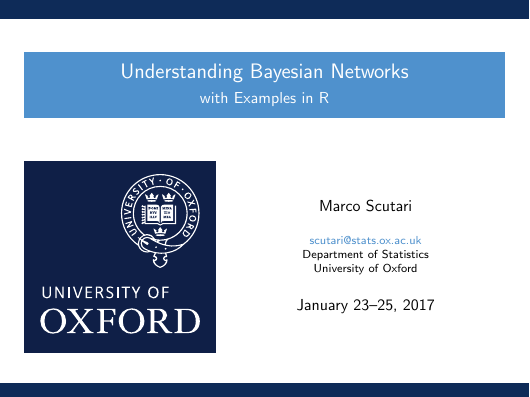

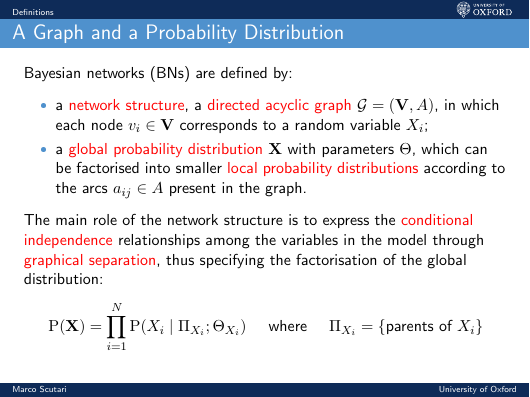
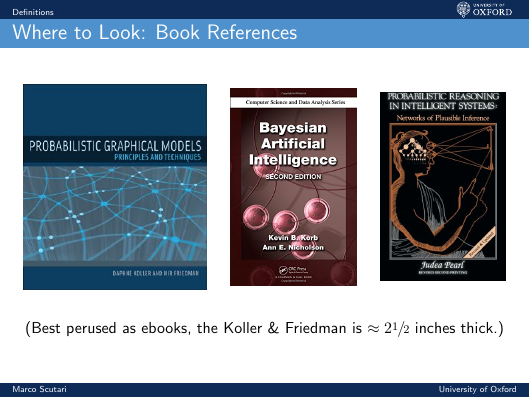
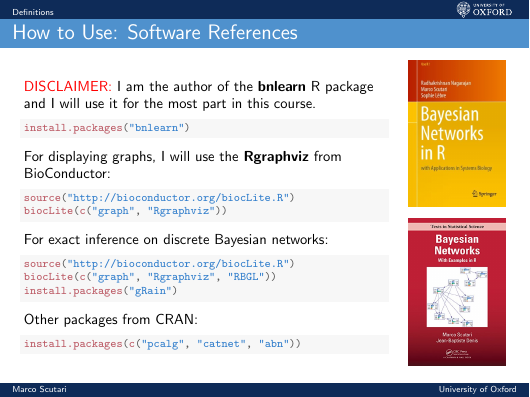
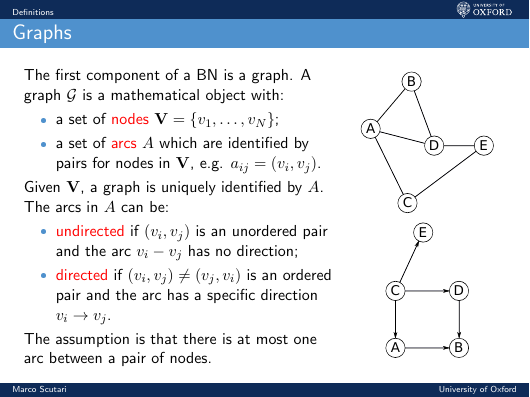
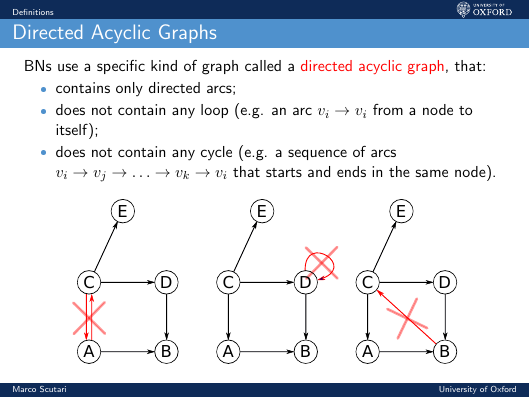
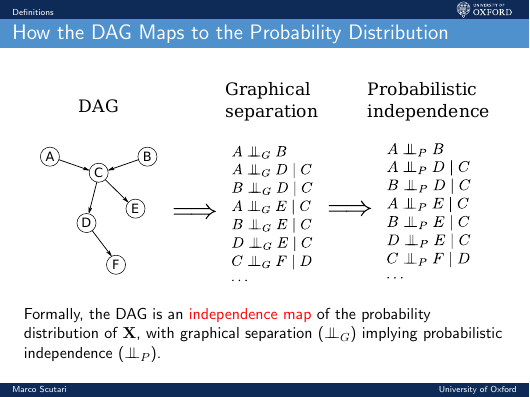








 2023年江西萍乡中考道德与法治真题及答案.doc
2023年江西萍乡中考道德与法治真题及答案.doc 2012年重庆南川中考生物真题及答案.doc
2012年重庆南川中考生物真题及答案.doc 2013年江西师范大学地理学综合及文艺理论基础考研真题.doc
2013年江西师范大学地理学综合及文艺理论基础考研真题.doc 2020年四川甘孜小升初语文真题及答案I卷.doc
2020年四川甘孜小升初语文真题及答案I卷.doc 2020年注册岩土工程师专业基础考试真题及答案.doc
2020年注册岩土工程师专业基础考试真题及答案.doc 2023-2024学年福建省厦门市九年级上学期数学月考试题及答案.doc
2023-2024学年福建省厦门市九年级上学期数学月考试题及答案.doc 2021-2022学年辽宁省沈阳市大东区九年级上学期语文期末试题及答案.doc
2021-2022学年辽宁省沈阳市大东区九年级上学期语文期末试题及答案.doc 2022-2023学年北京东城区初三第一学期物理期末试卷及答案.doc
2022-2023学年北京东城区初三第一学期物理期末试卷及答案.doc 2018上半年江西教师资格初中地理学科知识与教学能力真题及答案.doc
2018上半年江西教师资格初中地理学科知识与教学能力真题及答案.doc 2012年河北国家公务员申论考试真题及答案-省级.doc
2012年河北国家公务员申论考试真题及答案-省级.doc 2020-2021学年江苏省扬州市江都区邵樊片九年级上学期数学第一次质量检测试题及答案.doc
2020-2021学年江苏省扬州市江都区邵樊片九年级上学期数学第一次质量检测试题及答案.doc 2022下半年黑龙江教师资格证中学综合素质真题及答案.doc
2022下半年黑龙江教师资格证中学综合素质真题及答案.doc